How to make Tivoli Road Bakery's lamington doughnuts at home
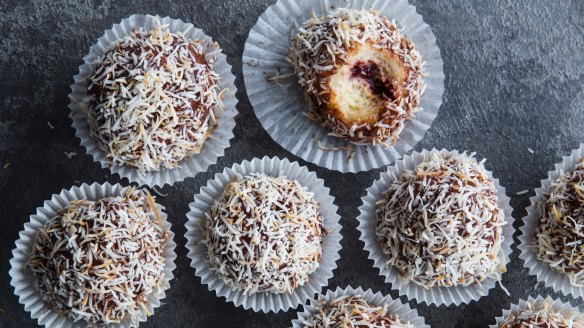
It is the time of year when we celebrate Australian food...but also look to reinvent it.
Lamington doughnuts
These were created as a fun alternative to a traditional lamington. We serve them at the bakery around Australia Day, and for other special Australian occasions.
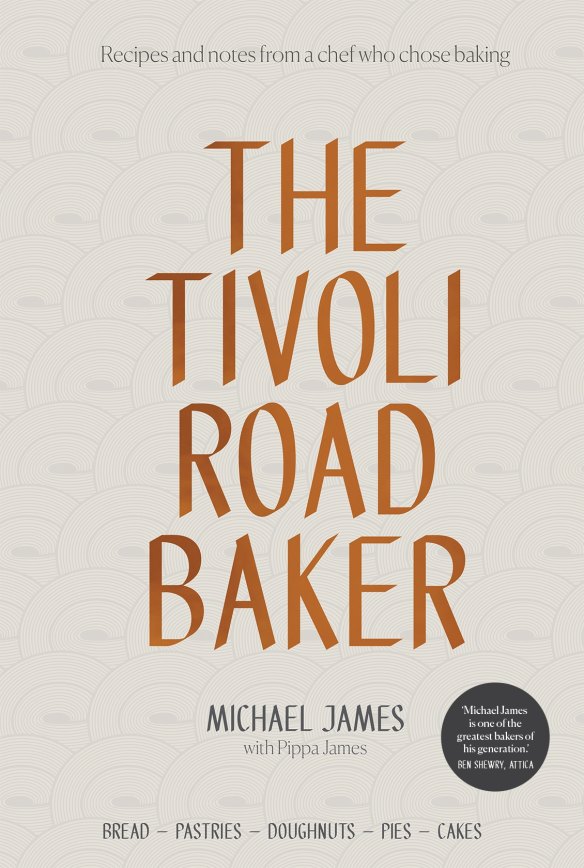
There is much debate between Australians as to whether a lamington should contain jam or not. My preference is based on taste, not tradition, and I have to say I love the combination of tart raspberry jam, chocolate and coconut.
INGREDIENTS
Coconut coating
200g shredded coconut
Chocolate ganache
100g dark chocolate, at least 70 per cent cocoa solids, roughly chopped
280g whipping cream, 35 per cent fat
15g glucose syrup
200g raspberry jam
1 quantity doughnuts (see below)
METHOD
1. To prepare the coconut, preheat the oven to 160C. Spread the coconut out over a tray lined with baking paper. Bake for three to four minutes, until lightly toasted, and set aside to cool.
2. To make the chocolate ganache, place the chocolate in a medium-sized metal bowl. Bring the cream and glucose syrup to a simmer in a heavy-based saucepan over medium heat, stirring to combine. Pour the cream over the chocolate and leave it to stand for a few minutes so the chocolate can melt, then mix thoroughly, stirring well to ensure there are no lumps of chocolate left.
3. Put the jam in a piping bag, make a slit in the side of a doughnut and insert the tip of the piping bag into it. Fill generously, but not so much that it is oozing out of the top.
4. Holding the doughnut over the bowl, use one hand to cover it in ganache, making sure you coat the entire surface well with chocolate. Repeat for the remaining doughnuts, putting them on a clean tray lined with baking paper as you go.
5. With clean hands (or clean gloves, if you prefer), roll each doughnut in the coconut, making sure the entire surface is coated. To keep things tidy, it's a good idea to place the doughnuts into patty pans once coated – this will stop the doughnuts rolling around, and gives people something to hold their doughnut in while they eat it.
Makes 10
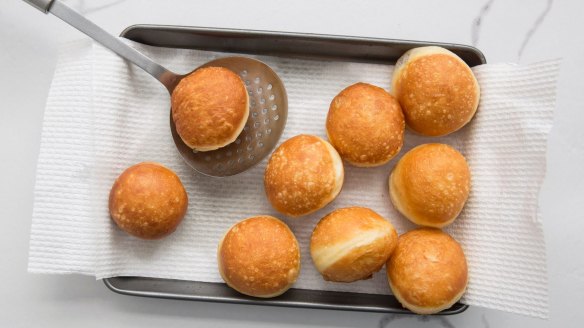
Doughnuts
INGREDIENTS
190g bakers flour
25g castor sugar
2g salt
zest of 1 lemon
8g fresh yeast
40g water
10g lemon oil
2 medium eggs, at room temperature
45g butter, diced and soft
1 litre vegetable oil, such as rice bran oil or cotton seed oil, for deep frying
Bakery notes: You need to use strong flour for this dough, with a high protein content, so it can hold the structure when frying. If lemon oil is not available, feel free to use a good extra virgin olive oil.
Make the dough the day before you fry the doughnuts. This allows the yeasty flavour to develop, and achieves a strong dough that is easier to handle.
If you can't get fresh yeast, you can substitute with dried yeast, but just remember that fresh yeast is heavier than dried yeast. One teaspoon of fresh yeast is equal to one teaspoon of dried yeast, but 10 grams of fresh yeast is equivalent to five grams dried yeast.
METHOD
1. Mix the flour, sugar, salt and lemon zest in a medium-sized bowl, and set aside. Combine the yeast, half the water, oil and eggs in the bowl of an electric mixer fitted with the dough hook. Add the flour mixture and mix on medium speed for 10 minutes, adding more water as needed to make a smooth dough.
2. Add the softened butter slowly while continuing to mix. Mix for five minutes, until the butter is fully incorporated. The dough should come away from the bowl and form a ball that is smooth, shiny and slightly sticky. Use the windowpane test to check the dough – take a small ball of dough and gently stretch it between your hands. You should be able to stretch it very thin without it breaking. If you find that it breaks easily, continue mixing for a few more minutes to work the gluten in the flour, then test it again. Leave the dough to rest in the bowl, covered with a damp tea towel, for one hour.
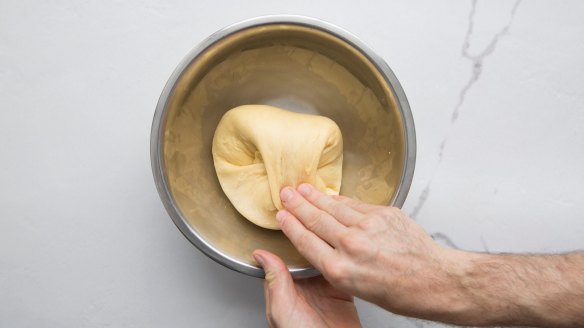
3. After an hour, knock back the dough and fold it by lifting one side up and over the other. Do this five or six times to develop strength in the dough. Transfer the dough to a lightly oiled container, then cover with a damp tea towel and refrigerate overnight to develop a complex, yeasty flavour.
4. Line two trays with baking paper, and spray the paper lightly with oil. Turn the dough out onto a lightly floured bench and cut it into 10 equal pieces. With each piece, gently flatten the dough and bring the edges together in the middle to form a rough ball, then turn it over so the seam is at the bottom. Cup your hand over the dough and use firm pressure to roll it on the bench until it forms a nice tight round ball with a smooth, even surface. Cover the doughnuts again with the damp tea towel, and leave them to rest for 15-20 minutes.
5. Take each doughnut and knock it flat, then fold the edges into the middle and turn it over so the seam is at the bottom. Using firm pressure, roll it in your hand on the bench again. Putting pressure on the doughnut strengthens the dough so it will rise well. Place the doughnuts on the lined trays, evenly spaced to allow for the eventual rise. Lightly cover with plastic wrap and leave to rise for two to three hours, or until risen by half. Test the doughnut by gently pressing the surface. If this leaves a dent, they are ready to fry, but if the dough springs back it still needs more time.
6. Heat the oil for deep frying to 180C in a large, heavy-based saucepan or deep fryer. The temperature is important. If it is too hot, the doughnuts will burn and be raw inside, but if it is not hot enough the doughnuts will stew in the oil and become soggy and greasy. Fry the doughnuts a few at a time, being careful not to overcrowd the pan, for about one minute on each side, until golden. Use a slotted spoon to turn them and remove them from the oil, onto a plate lined with paper towel. Set them aside to cool, then dust them in cinnamon sugar and cut a slit in the side, ready for filling.
Makes 10
Pork, caramelised apple and fennel sausage roll
After baking so many sausage rolls at Bourke Street Bakery and seeing them become a cult item, I knew we had to develop our own delicious version to please the crowds. These are often the first lunch item to sell out.
These sausage rolls are great for picnics, and they will be a smash hit at your next children's party. If you like, you could pipe the sausage mix a bit thinner and make smaller slices for party-sized sausage rolls.
If using store-bought puff pastry, you may need to adjust the size and produce a different number, depending on the size and shape your pastry is rolled to.
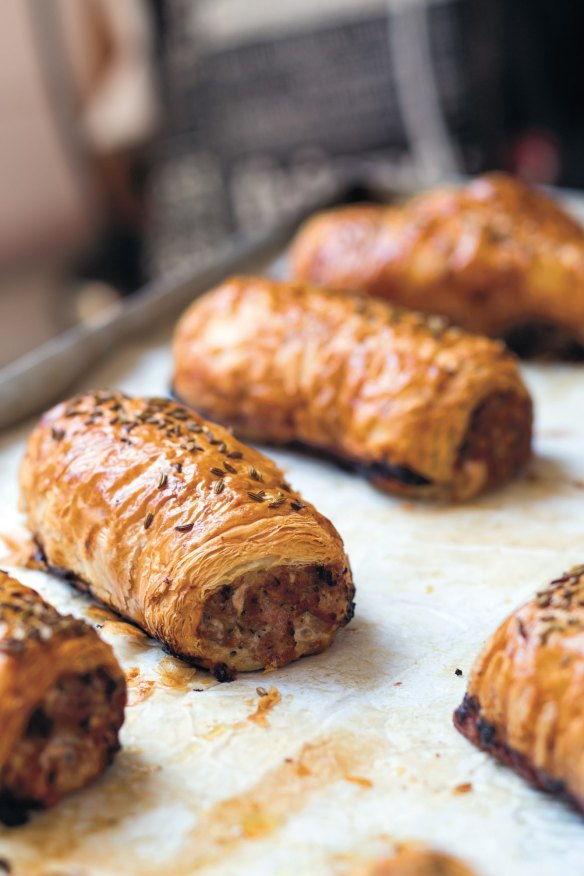
INGREDIENTS
2 tsp fennel seeds, plus extra to sprinkle
1 tbsp vegetable oil
3 medium brown onions, peeled and diced
4 cloves garlic, peeled and finely chopped
8 sprigs sage, picked and finely chopped
3 sprigs rosemary, leaves picked and finely chopped
5 sprigs thyme, leaves picked and finely chopped
20g unsalted butter
2 granny smith apples, peeled and cut into ½ cm dice
1 tbsp castor sugar
1 tbsp sherry vinegar
1.2kg pork mince
65g breadcrumbs
12g table salt
1 quantity puff pastry (you can make your own or use store-bought)
1 egg, lightly beaten
METHOD
1. Toast the fennel seeds in a large frying pan over a low heat for one to two minutes, until fragrant. Crush lightly in a mortar and pestle and set aside.
2. Using the same pan, heat the vegetable oil over a low heat. Sweat the onions and garlic for eight to 10 minutes until lightly caramelised, to give a bit of sweetness. Add the toasted fennel seeds, sage, rosemary and thyme and set aside to cool.
3. Wipe out the pan then melt the butter in it over a medium–high heat. Add the apples and toss gently in the butter for two minutes, then add the sugar. Continue to cook, stirring constantly, until the sugar is lightly caramelised, then add the vinegar to deglaze the pan. Set aside.
4. Combine the mince, breadcrumbs, salt and apples in a large mixing bowl. Add the onion and garlic mixture and mix it through with your hands for three to five minutes, until all the elements are evenly distributed through the mince.
5. On a lightly floured work surface, roll out the puff pastry into a sheet roughly 30 centimetres x 50 centimetres, and five millimetres thick (or use pre-rolled puff pastry). Cut it into four pieces 15 centimetres x 25 centimetres, with the long edges towards you.
6. Divide the sausage mix evenly between the four sheets, making a line of filling from left to right a third of the way up each sheet. (At the bakery we use a large piping bag for this.)
7. Lightly brush the beaten egg along the top edge of each piece, then roll the pastry up from the bottom of each roll, away from you, folding it over the sausage mix. Seal the roll on the egg-washed edge so the seam sits underneath the meat.
8. Egg wash the top and sides, then sprinkle with fennel seeds and lightly pierce along the top with a fork. Cut each roll in half, then lay your sausage rolls on a tray lined with baking paper and rest them in the fridge for half an hour.
9. Preheat the oven to 180C. Bake the sausage rolls from cold for 10 minutes, then reduce the heat to 160C and bake for a further 30 minutes until golden. Allow the sausage rolls to rest for 10 minutes before eating.
Makes 8 large sausage rolls
Potato, mushroom and taleggio pie
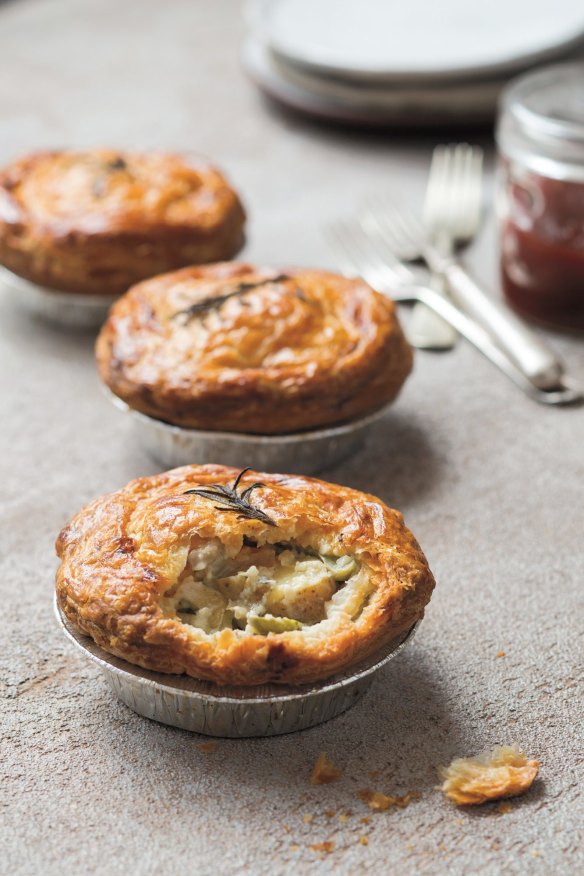
This might seem like an unusual filling for a pie, but it has a great conversion rate with the sceptics.
INGREDIENTS
540g savoury shortcrust pastry
400g puff pastry
For the filling
500g kipfler potatoes, washed
4 sprigs rosemary
50ml vegetable oil
75g unsalted butter
1 brown onion, peeled and diced
2 cloves garlic, peeled and finely chopped
200g button mushrooms, quartered
40g plain flour
400ml full-cream milk
200g taleggio, chopped into small pieces
2 sprigs tarragon, picked and roughly chopped
salt and freshly ground black pepper, to taste
12 cornichons, cut in half lengthways
Assembly
1 egg, lightly beaten
METHOD
1. Roll out the savoury shortcrust pastry into a sheet roughly four millimetres thick. Wrap the sheet in plastic wrap and place it in the fridge. Roll the puff pastry into a sheet roughly three millimetres thick, wrap it in plastic wrap and place it in the fridge. Let the pastry rest after rolling it out – this will stop it shrinking once cut.
2. To make the filling, put the potatoes in a large saucepan, cover with water and season with salt. Bring to the boil, then reduce the heat and simmer for 20 minutes. Strain the potatoes and refresh them briefly under cold water. Quarter them lengthways, then cut into two-centimetre slices and place in a large mixing bowl.
3. Strip the leaves from three sprigs of rosemary and finely chop. Heat 20 millilitres of the oil and 20 grams of the butter in a large saucepan, then add the onion and garlic and sweat them off until soft and translucent. Remove from the heat, stir through the rosemary and add the mixture to the potato.
4. Heat a large frying pan over a high heat, then add the remaining oil and 15 grams of the butter. Fry the mushrooms for five minutes, until softened and starting to colour, then add to the potato and onions.
5. Melt the remaining 40 grams of butter in a saucepan over a medium heat. Add the flour and stir over the heat until it forms a thick, sandy-coloured paste. Gradually whisk in the milk, then continue to stir until the mixture is thick and comes to the boil. Remove from the heat, add the taleggio and continue whisking until smooth.
6. Pour the cheese sauce over the potatoes, onions and mushrooms. Add the tarragon and gently turn the mixture until everything is well coated in the sauce. Season to taste with salt and pepper. Set aside to cool completely.
7. Before you assemble the pies, preheat the oven to 180C and lightly grease your pie dishes. Lay the savoury shortcrust pastry on a lightly floured bench, and cut out eight discs of pastry for the bases, two centimetres wider in diameter than the base of your pie dishes.
8. Line each pie dish with a round of shortcrust pastry and press it in well with your thumb. Trim off any excess and lightly brush the edges with the beaten egg. Lay out your puff pastry and cut eight discs slightly larger than the top of your pie dishes. Fill each pie generously with the filling and place three slices of cornichon on top. Top each pie with a puff pastry lid and press the edges of the base and lid together to seal.
9. Brush the top of each pie with egg wash, then pierce it a couple of times with a sharp knife. Strip the leaves from the remaining sprig of rosemary and sprinkle them over the top. Bake at 180C for 10 minutes and then reduce the heat to 160C, before baking for a further 30-40 minutes, until the pies are nice and golden. Allow them to rest for 10 minutes before eating.
Makes 8 individual pies or 1 family pie
Savoury shortcrust pastry
INGREDIENTS
90g water
10g white vinegar
320g plain flour
10g table salt
110g unsalted butter, cold, cut into 1cm dice
Bakery notes: This dough will set hard as it contains lots of butter, so take it out of the fridge at least an hour before using, so it's easy to roll. You want the pastry to be malleable without being too soft. Having a few streaks of butter visible in the finished dough will result in a flaky texture once baked.
METHOD
1. Combine the water and vinegar in a jug. Put the flour, salt and butter in the bowl of a stand mixer fitted with the paddle attachment and beat the butter into the flour, mixing until you have pea-sized lumps of butter. With the mixer still running, slowly pour in the combined water and vinegar, and mix until the dough just comes together. You don't want any dry pieces, but you need to be careful not to overwork it. You can add a bit more water if you have any dry clumps, but don't let the dough get sticky.
2. If you are mixing the dough by hand, combine the flour and salt in a medium sized bowl and toss through the chilled butter. Use your fingertips to rub the butter into the flour until just combined and you still have pea-sized lumps of butter visible. Tip the mixture out onto the bench. Slowly pour the combined water and vinegar over the top, using the heel of your hand to work the mixture into a dough. Push it away from your body and then gather it together with both hands. Repeat this a few times until it all comes together and no flour is visible.
3. Wrap the dough in plastic wrap, and refrigerate for at least an hour before using. If it's wrapped well, savoury shortcrust will keep for a week in the fridge, or up to three months in the freezer.
Makes 540g
This is an edited extract from The Tivoli Road Baker by Michael James, with Pippa James, published by Hardie Grant Books, RRP $60. It is available in stores nationally; Photographer: ©Bonnie Savage & Alan Benson.
The best recipes from Australia's leading chefs straight to your inbox.
Sign up